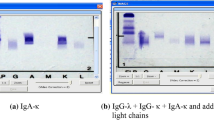Abstract
Multiple myeloma (MM) is characterized by clonal expansion of malignant bone marrow cells producing a unique monoclonal immunoglobulin. The appearance of abnormal protein band (APB) in MM has been reported during follow-up. We aimed to evaluate the clinical characteristics and outcomes of patients with APB in a single center cohort. A total of 377 consecutive MM patients were treated at the Asan Medical Center between January 2002 and December 2012. We compared clinical characteristics and survival outcome between those with and without APB. Of the 377 patients, 34 (9 %) experienced APB. They comprised 18.2 % (27/148) of patients treated with autologous stem cell transplantation (ASCT) and 3.1 % (7/229) of those not receiving ASCT. APB occurred after a median of 7.9 months (range, 2.2–95.7 months) from diagnosis. Immunoglobulin isotypes at diagnosis were as follows: IgG (n = 10), IgA (n = 8), IgD (n = 5), free κ (n = 4), and free λ (n = 7). Nine patients experienced a second APB. With a median follow-up of 54.1 months, the median overall survival (OS) has not been reached in patients with APB and was 38.3 months in patients without (P < 0.001). Multivariate analysis indicated that the development of APB was a significant favorable prognostic factor for OS (hazard ratio 0.21; 95 % confidence interval 0.08–0.52). Serum β2-microglobulin, albumin, creatinine, and ASCT were also independent prognostic factors for OS. Further investigation is required to establish the mechanisms underlying APB in MM.

Similar content being viewed by others
References
Mitsiades CS, Mitsiades N, Munshi NC, Anderson KC (2004) Focus on multiple myeloma. Cancer Cell 6(5):439–444
Durie BG, Harousseau JL, Miguel JS, Blade J, Barlogie B, Anderson K, Gertz M, Dimopoulos M, Westin J, Sonneveld P, Ludwig H, Gahrton G, Beksac M, Crowley J, Belch A, Boccadaro M, Cavo M, Turesson I, Joshua D, Vesole D, Kyle R, Alexanian R, Tricot G, Attal M, Merlini G, Powles R, Richardson P, Shimizu K, Tosi P, Morgan G, Rajkumar SV (2006) International uniform response criteria for multiple myeloma. Leukemia 20(9):1467–1473
Rajkumar SV, Harousseau JL, Durie B, Anderson KC, Dimopoulos M, Kyle R, Blade J, Richardson P, Orlowski R, Siegel D, Jagannath S, Facon T, Avet-Loiseau H, Lonial S, Palumbo A, Zonder J, Ludwig H, Vesole D, Sezer O, Munshi NC, San Miguel J (2011) Consensus recommendations for the uniform reporting of clinical trials: report of the International Myeloma Workshop Consensus Panel 1. Blood 117(18):4691–4695
Fernandez de Larrea C, Tovar N, Cibeira MT, Arostegui JI, Rosinol L, Elena M, Filella X, Yague J, Blade J (2011) Emergence of oligoclonal bands in patients with multiple myeloma in complete remission after induction chemotherapy: association with the use of novel agents. Haematologica 96(1):171–173
Zent CS, Wilson CS, Tricot G, Jagannath S, Siegel D, Desikan KR, Munshi N, Bracy D, Barlogie B, Butch AW (1998) Oligoclonal protein bands and Ig isotype switching in multiple myeloma treated with high-dose therapy and hematopoietic cell transplantation. Blood 91(9):3518–3523
Maisnar V, Tichy M, Smolej L, Zak P, Radocha J, Palicka V, Maly J, Blaha V (2007) Isotype class switching after transplantation in multiple myeloma. Neoplasma 54(3):225–228
Alejandre ME, Madalena LB, Pavlovsky MA, Facio ML, Corrado C, Milone G, Bresciani PD, Fraind SA, Pavlovsky S, Pizzolato MA (2010) Oligoclonal bands and immunoglobulin isotype switch during monitoring of patients with multiple myeloma and autologous hematopoietic cell transplantation: a 16-year experience. Clin Chem Lab Med 48(5):727–731. doi:10.1515/CCLM.2010.050
Liu AJ, Zong H, Yang GZ, Zhai YH, Li LH (2012) Significance of oligoclonal bands after stem cell transplantation in multiple myeloma cases. Asian Pac J Cancer Prev 13(4):1483–1486
Guimaraes C, Bergantim R, Ramalho R, Couto N, Guimaraes JT, Trigo F (2012) Prognostic value of unrelated atypical serum immunofixation patterns during multiple myeloma therapy. J Hematol Oncol 5:33
Hovenga S, de Wolf JT, Guikema JE, Klip H, Smit JW, Smit Sibinga CT, Bos NA, Vellenga E (2000) Autologous stem cell transplantation in multiple myeloma after VAD and EDAP courses: a high incidence of oligoclonal serum Igs post transplantation. Bone Marrow Transplant 25(7):723–728
Byrne E, Giles C, Andrews J, Rahemtulla A, Naresh KN (2011) Lack of correlation between emergence of an abnormal protein band or of oligoclonal bands and survival in patients with multiple myeloma achieving complete remission following autologous stem cell transplantation. Haematologica 96(4):e29
The International Myeloma Working G (2003) Criteria for the classification of monoclonal gammopathies, multiple myeloma and related disorders: a report of the International Myeloma Working Group. British J Haematol 121(5):749–757. doi:10.1046/j.1365-2141.2003.04355.x
Greipp PR, San Miguel J, Durie BG, Crowley JJ, Barlogie B, Blade J, Boccadoro M, Child JA, Avet-Loiseau H, Harousseau JL, Kyle RA, Lahuerta JJ, Ludwig H, Morgan G, Powles R, Shimizu K, Shustik C, Sonneveld P, Tosi P, Turesson I, Westin J (2005) International staging system for multiple myeloma. J Clin Oncol 23(15):3412–3420
Kim JE, Yoo C, Lee DH, Kim SW, Lee JS, Suh C (2010) Serum albumin level is a significant prognostic factor reflecting disease severity in symptomatic multiple myeloma. Ann Hematol 89(4):391–397. doi:10.1007/s00277-009-0841-4
Small TN, Keever CA, Weiner-Fedus S, Heller G, O’Reilly RJ, Flomenberg N (1990) B-cell differentiation following autologous, conventional, or T-cell depleted bone marrow transplantation: a recapitulation of normal B-cell ontogeny. Blood 76(8):1647–1656
Acknowledgments
The authors thank the nursing and medical staff of the Asan Medical Center for their excellent support and dedication that has made this study possible.
Conflict of interest
The authors declare that they have no conflict of interest.
Author information
Authors and Affiliations
Corresponding author
Additional information
Jae-Cheol Jo and Dok Hyun Yoon contributed equally to this work.
Appendix
Appendix
Rights and permissions
About this article
Cite this article
Jo, JC., Yoon, D.H., Kim, S. et al. Clinical significance of the appearance of abnormal protein band in patients with multiple myeloma. Ann Hematol 93, 463–469 (2014). https://doi.org/10.1007/s00277-013-1890-2
Received:
Accepted:
Published:
Issue Date:
DOI: https://doi.org/10.1007/s00277-013-1890-2




